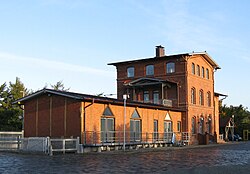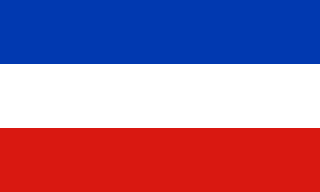
Schleswig-Holstein is the northernmost of the 16 states of Germany, comprising most of the historical Duchy of Holstein and the southern part of the former Duchy of Schleswig. Its capital city is Kiel; other notable cities are Lübeck and Flensburg. It covers an area of 15,763 km2 (6,086 sq mi), making it the 5th smallest German federal state by area. Historically, the name can also refer to a larger region, containing both present-day Schleswig-Holstein and the former South Jutland County in Denmark.

Southern Schleswig is the southern half of the former Duchy of Schleswig in Germany on the Jutland Peninsula. The geographical area today covers the large area between the Eider river in the south and the Flensburg Fjord in the north, where it borders Denmark. Northern Schleswig, congruent with the former South Jutland County, forms the southernmost part of Denmark. The area belonged to the Crown of Denmark until Prussia and Austria declared war on Denmark in 1864. Denmark wanted to give away the German-speaking Holsten and set the new border at the small river Ejderen. Prussian chancellor Otto von Bismarck concluded that this justified a war, and even proclaimed it a "holy war". He also turned to the Emperor of Austria, Franz Joseph I of Austria for help. A similar war in 1848 had gone poorly for the Prussians. With Prussia's modern weapons and the help from both the Austrians and General Moltke, the Danish army was destroyed and forced to make a disorderly retreat. The Prussian-Danish border was then moved from the Elbe up in Jutland to the Kongeåen creek.

The Duchy of Schleswig was a duchy in Southern Jutland covering the area between about 60 km north and 70 km (45 mi) south of the current border between Germany and Denmark. The territory has been divided between the two countries since 1920, with Northern Schleswig in Denmark and Southern Schleswig in Germany. The region is also called Sleswick in English.
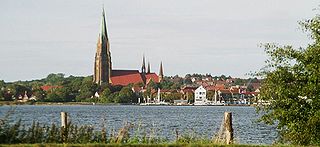
Schleswig is a town in the northeastern part of Schleswig-Holstein, Germany. It is the capital of the Kreis (district) Schleswig-Flensburg. It has a population of about 27,000, the main industries being leather and food processing. It takes its name from the Schlei (Slien), an inlet of the Baltic Sea at the end of which it sits, and vik or vig which means "bay" in Old Norse and Danish. Schleswig or Slesvig therefore means "bay of the Schlei".

Flensburg is an independent town in the far north of the German state of Schleswig-Holstein. After Kiel and Lübeck, it is the third-largest town in Schleswig-Holstein.

Christian I(Christiern I) was a German noble and Scandinavian monarch under the Kalmar Union. He was king of Denmark (1448–1481), Norway (1450–1481) and Sweden (1457–1464). From 1460 to 1481, he was also duke of Schleswig and count of Holstein. He was the first king of the House of Oldenburg.

Angeln is a peninsula on the Baltic coast of Jutland, in the Bay of Kiel. It forms part of Southern Schleswig, the northernmost region of Germany. The peninsula is bounded on the north by the Flensburg Firth, which separates it from Sundeved and the island of Als in Denmark, and on the south by the Schlei, which separates it from Schwansen. The landscape is hilly, dotted with numerous lakes. The largest towns are Flensburg, Schleswig and Kappeln.
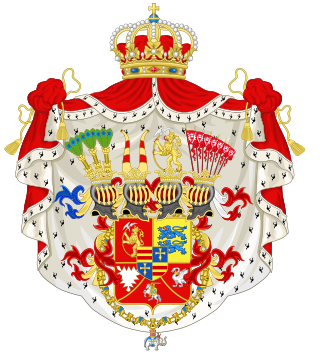
The House of Schleswig-Holstein-Sonderburg-Glücksburg, also known by its short name as the House of Glücksburg, is the senior surviving branch of the German House of Oldenburg, one of Europe's oldest royal houses. Oldenburg house members have reigned at various times in Denmark, Norway, Sweden, Iceland, Greece, several northern German states, Russia and the United Kingdom. It takes its name from the family seat in Glücksburg, a small town in Schleswig-Holstein, Germany.

The Second Schleswig War, also sometimes known as the Dano-Prussian War or Prusso-Danish War, was the second military conflict over the Schleswig-Holstein Question of the nineteenth century. The war began on 1 February 1864, when Prussian and Austrian forces crossed the border into the Danish fief Schleswig. Denmark fought troops of the Kingdom of Prussia and the Austrian Empire representing the German Confederation.

Gelting is a municipality in the district of Schleswig-Flensburg, in Schleswig-Holstein, Germany. It is situated near the Baltic Sea, approx. 33 km northeast of Schleswig, and 30 km east of Flensburg.

Handewitt is a municipality in the district of Schleswig-Flensburg, in Schleswig-Holstein, Germany. It is situated near the border with Denmark, approximately 7 km west of Flensburg.

Oeversee is a municipality in the district of Schleswig-Flensburg, in Schleswig-Holstein, Germany. It is situated approximately 10 km south of Flensburg. The Oeversee municipality was merged with Sankelmark on March 1, 2008. The new municipality is, however, still called Oeversee.
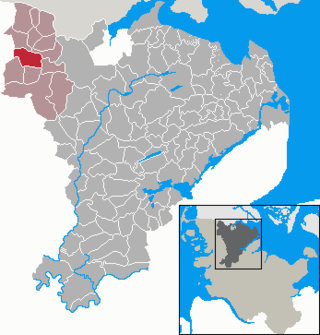
Schafflund is a municipality in the district of Schleswig-Flensburg, in Schleswig-Holstein, Germany. It is situated approximately 16 km west of Flensburg.

Großenwiehe is a municipality in the district of Schleswig-Flensburg, in Schleswig-Holstein, Germany.

Großsolt is a municipality in the district of Schleswig-Flensburg, in Schleswig-Holstein, Germany.

Hasselberg is a municipality in the district of Schleswig-Flensburg, in Schleswig-Holstein, Germany.

Hörup is a municipality in the district of Schleswig-Flensburg, in Schleswig-Holstein, Germany.

Stoltebüll is a municipality in the district of Schleswig-Flensburg, in Schleswig-Holstein, Germany.

Wanderup is a municipality in the district of Schleswig-Flensburg, in Schleswig-Holstein, Germany.

Rahlstedt is a quarter (Stadtteil) in the Wandsbek borough (Bezirk) of the Free and Hanseatic city of Hamburg in northern Germany. In 2020, the population was 92,511.
